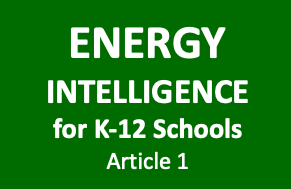- 2 reads

As one of the Youth Ambassadors at the Energy Intelligence Center I am pleased to share my research and findings with you. As climate change becomes an increasing concern in the U.S. and around the world sustainability and energy intelligence are more important now than ever before. Cost effective technologies are available through a broad range of companies that have delivered proven results. As K-12 schools look to reduce operating expenses and also increase STEM education, energy intelligence measures can help reach both goals, while simultaneously fostering environmental stewardship. The following information is relevant to energy intelligence for K-12 schools and it will hopefully inspire other schools as well as business to take action:
RTIS Helps Schools and Universities Optimize Energy, Reduce Costs, and Improve Sustainability
Schools and colleges operate differently than most other organizations, as their schedules and goals are centered around the needs of students, faculty, parents, and other community stakeholders, rather than serving clients. Thus, they have unique challenges and energy management needs.
Using the RTIS energy analytics platform, schools can identify and mitigate inefficient practices and wasted energy usage, improve sustainability performance and awareness, and create opportunities in their budgets to invest in additional educational programs.
Source: https://www.artisenergy.com/industries/k-12-higher-education/
HANDS-ON ACTIVITY Energy Intelligence Agency
Summary
In an active way, students discover a few critical facts about how we use energy and how much energy we use. Each student has a "clue," some of which are pertinent energy facts and others are silly statements that are clearly unrelated to the topic. Students mingle and ask each other for clues until they have collected all the facts they need. This provides a more interactive way to communicate energy statistics, compared to a lecture and introduction with board work. The goal is to introduce students to some key terms and issues associated with energy as a necessary prerequisite for the remainder of the unit. This engineering curriculum aligns to Next Generation Science Standards (NGSS).
Source: https://www.teachengineering.org/activities/view/cla_activity1_energy_intelligence
ENERGY STAR Score for K-12 Schools
The ENERGY STAR Score for K-12 Schools applies to buildings or campuses used as a school for kindergarten through 12th grade students. The objective of the ENERGY STAR score is to provide a fair assessment of the energy performance of a property relative to its peers, taking into account the climate, weather, and business activities at the property. To identify the aspects of building activity that are significant drivers of energy use and then normalize for those factors, a statistical analysis of the peer building population is performed. The result of this analysis is an equation that will predict the energy use of a property, based on its experienced business activities. The energy use prediction for a building is compared to its actual energy use to yield a 1 to 100 percentile ranking of performance, relative to the national population.
-
Property Types. The ENERGY STAR score for K-12 schools applies to a property used as a school for kindergarten through 12th grade students. The score applies to an entire school whether it is a single building or a campus of buildings.
-
Reference Data. The analysis for K-12 schools is based on data from the Department of Energy, Energy Information Administration’s 2012 Commercial Building Energy Consumption Survey (CBECS).
-
Adjustments for Weather and Business Activity. The analysis includes adjustments for:
-
Number of Workers
-
Whether or not the School is Open on Weekends
-
Whether or not there is Energy Used for Cooking
-
Whether or not the School is a High School
-
Weather and Climate (using Heating and Cooling Degree Days, retrieved based on Zip code)
-
Percent of the Building that is Heated and Cooled
-
-
Release Date. The ENERGY STAR score for K-12 schools is updated periodically as more recent data becomes available:
-
Most Recent Update: August 2018
-
Previous Update: February 2009
-
Original Release: April 2000
-
This document presents details on the development of the 1 - 100 ENERGY STAR score for K-12 school properties. More information on the overall approach to develop ENERGY STAR scores is covered in our Technical Reference for the ENERGY STAR Score, available at www.energystar.gov/ENERGYSTARScore. The subsequent sections of this document offer specific details on the development of the ENERGY STAR score for K-12 schools.
Download more information about the ENERGY STAR score for K-12 schools here. (PDF, 1020.08 KB )
Topic: Portfolio Manager, ENERGY STAR score calculation details, Technical reference
Resource Type: Technical documentation
Source: https://www.energystar.gov/buildings/tools-and-resources/energy-star-score-k-12-schools
For more information on sustainability practices see this Energy Intelligence page for a range of clean-technologies

